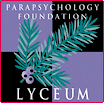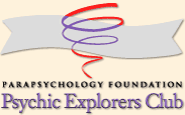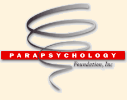 |
 |
| THE BIOGRAPHICAL DICTIONARY OF PARAPSYCHOLOGY FABIO DA SILVA This autobiography was written for the PF Lyceum Blog #11, “Lives in Parapsychology.” A more formal biography will be posted in the coming months. Fabio Eduardo da Silva  My interest in parapsychology began when I was a teenager. I took part in several groups of self-knowledge (or self-awareness) and meditation. In some of these groups I heard about psychic abilities and about parapsychology. At that time I used to meditate twice per day. One day I had a spontaneous out-of-body experience (OBE) and it had a great impact on my life. I started reading books about OBEs and initiated regular practice, trying to have the experience again. I had several spontaneous and intentional OBEs through these practices, but one day I had a very bad OBE experience and gave it up. My interest in parapsychology began when I was a teenager. I took part in several groups of self-knowledge (or self-awareness) and meditation. In some of these groups I heard about psychic abilities and about parapsychology. At that time I used to meditate twice per day. One day I had a spontaneous out-of-body experience (OBE) and it had a great impact on my life. I started reading books about OBEs and initiated regular practice, trying to have the experience again. I had several spontaneous and intentional OBEs through these practices, but one day I had a very bad OBE experience and gave it up.
Reading a popular magazine I discovered the Parapsychology Course being given in Curitiba. Although this city was 900 kilometers away from my home city, I decided to do this course and I moved to Curitiba. I began studying parapsychology in 1991. I completed the four-year Open Course of Parapsychology at the Biopsychic College of the Spiritual Integrated Colleges. In 1996 I started working in this course as an assistant in three areas of specialization: (1) Methods and techniques in experimental Parapsychology; (2) Statistics applied to Parapsychology and (3) Personal dynamics for self-knowledge. In 1997 I was invited to coordinate the College’s Ganzfeld Laboratory. In order to do this, a group of my colleagues and I were trained by Dr. Kathy Dalton who came to Brazil especially for this purpose. Encouraged by Dr. Kathy Dalton I attended the Rhine Research Center’s Summer Study Program in Parapsychology in 1998. This course was a crucial influence on my career both because I came into contact with and was trained by experienced researchers, and because I was introduced to the abundant international literature of the field. After attending a few of the Annual Conventions of the Parapsychological Association, I was more able to carry out successfully my first Ganzfeld project, and in 2000, I obtained my first grant from the Bial Foundation to conduct it. In 2002, some of my colleagues and I finished both our Ganzfeld and our non-Ganzfeld research. Among the results two aspects stand out. First, we found unexpected qualitative information in the participant’s mentation. There were different patterns of responses in the hits and misses. We called those “hits” that showed a strong correlation between the contents of the report and the characteristics of the target, and the subject chose the correct target, “quality hits.’. On the other hand, we called those “misses” in which the mentation content was also accurate, but related to one or more of the distractors in the target pool, and in which the subject chose an item that had not been the target, a “quality miss.” In spite of some methodological differences, our findings were similar to the qualitative results found by Adrian Parker and his colleagues in Sweden, as reported in articles they published in 1999 and 2000. Because of these results, we began to think that it was possible that the methodology used to evaluate ESP, that is, the notion of “hits” and “misses” in relation to whether one chooses the correct target out of the item pool that contains both the correct one and the incorrect ones, may be inappropriate or incomplete. The qualitative information of our study seemed to show misses were more suggestive of ESP than many of the hits. If ESP had actually occurred in these “quality misses” and hadn’t occurred in some hits without quality, how could we be sure that we are obtaining reliable information when hits are analyzed in relation to other variables? Second, we noticed that when some subjects “learn[ed] about their own way of expressing psi” (through analyzing and discussing the sessions, and by training themselves using different techniques), they did better in the future trials, producing more “quality” hits or misses. These two insights inspired two new integrated studies. In 2002 we developed the “Digital and Physiological Ganzfeld: Looking for a More Objective Measure of Psi” Project and received our second Bial Foundation grant. This study which began in 2003 and will finish this year, in 2006, tries to solve the problem of reliability by integrating the “Digital Ganzfeld Technique” (a real-time system to evaluate the cognitive aspects of psi) with the DMILS (Direct Mental Interactions with Living Systems) Technique which measures electrodermal activity (EDA) as a physiological measurement of psi. We are asking whether this intergration of techniques will produce a more objective measure of psi. (The Real-Time Digital Ganzfeld System was developed by Dr. Adrian Parker and Dr. Joakim Westerlund of University of Gothenburg in Sweden. During the sending/receiving period the reports of the receiver are recorded. During the target evaluation, that is, the “judging process,” the receiver is able to listen to his or her mentation while watching each target in a synchronized way. It is thought that this method of feedback may facilitate the receiver’s perception of the moments during which he or she described the target in real-time.) The second insight of our earlier study is being addressed through a project we call “Is it possible to stimulate the consciousness or perception of anomalous experiences daily and in the laboratory? An exploratory study with group dynamics and deep experiences in Parapsychology.” This study began in 2005 and will be completed in 2008. Since I’ve been working with group dynamics and deep experiences for several years I have seen what seems to be psi phenomena happening spontaneously. Perhaps the “warm” environment of these groups integrated with creative and altered states of consciousness practices have facilitated psi experiences. For this study we are integrating these practices (which we suppose may be psi-conductive) with an attempt to stimulate psi perceptions through systematic observation techniques used both in the group meetings and in daily life. Through this exploratory research, we also hope to investigate the social role of psi experiences. The people who are being trained (through group dynamics techniques) are stimulated by the experience to try and use psi/intuition in their daily lives, to solve problems and make decisions. The subjects trained in this study will also be tested using the integrated methodology of the Digital and Physiological Ganzfeld Project. We hope that the integration of the experimental with the phenomenological, the quantitative with the qualitative will advance the study of anomalous phenomena. Back in 2002 we expanded the Ganzfeld Laboratory facilities at our college and created a new program we call CIPE (Intergrated Experimental Parapsychology Center), which includes four laboratories: DMILS, Ganzfeld, Micro-PK, and Remote Viewing. (For more information on this laboratory, albeit in Portuguese, click here.) My colleagues — Reginaldo Hiraoka, Sibele Pilato and Mauricio Silva — and I came to believe then that we needed to expand not just our researches facilities but also our integration and collaboration with other researchers. To do this we decided to adopt two strategies: (1) we began to participate in national events (in São Paulo, Recife and Joinville) and to plan for our own conference, “Psi Meeting” held in Curitiba. In the first edition of the meeting in 2002, about 40 people participated, most of them from Curitiba and São Paulo. For the second “Psi Meeting” held in 2004, about 80 people participated from five different countries: Argentina, Brazil, Chile, France, Japan and the USA. At the same time, we promoted the First “Journey of Altered States of Consciousness” in which participants were involved in different rituals and practices. The third “Psi Meeting: Real-Life Implications and Applications of Psi,” and The Second Journey of Altered States of Consciousness will be held in April, 2006. As a consequence of the Second Psi Meeting in 2004, we were involed in a cooperative exchange with two Japanese Researchers: Tatsu Hirukawa, who is an Associate Professor of Anthropology and a member of the School of Information and Communication at Meiji University, and Hideyuki Kokubo, a Senior Scientist of the International Research Institute (IRI), also of Meiji University. Hirukawa and Kokubo trained us in Micro-PK research using an RNG (especially in the field of consciousness research), in DMILS using EDA measurement and in a Chinese technique used to train children in clairvoyance. Another fruitful outcome of our Psi Meeting was the project we conducted in 2005 which we called “Distant Healing with Autistic Patients: An Exploratory Study Considering Physical and Psychological Variables.” In this exploratory, double-blind study, 10 “psychic healers&rquo; sent their distant healing intention to 5 patients (the test group) over 25 days in November and December 2005. Psychic healers from different countries and religions were selected and monitored by different researchers. The healers only received a picture of the patients and did their “healing work” in their own environment. This research represents an effort of integration and cooperation among researches and psychic healers from different countries: Chile (working with Lic. Sergio Schilling and Lic. Waldo Mora); Peru (working with Lic. Luis S. Espinoza Paul); Japan (working with Prof. Hideyuki Kokubo, BSc), and Brazil (with myself, Prof. Nardir Ganz, Ms. Magda Jakeline, Prof. Julia Hein and Prof. Dr. Raimundo Facion as the research team). Each group of researchers organized the local psychic healers to participate. Also in 2005 I concluded my own undergraduate psychology degree, graduating from the Universidade Tuiuti do Paraná, where I also obtained a qualification in teaching (Magistério Superior). I am now doing another undergraduate course of specialization in neuropsychology, and I have just been accepted for the masters degree program at the University of São Paulo where my research project will be in experimental psi research. Drs. Wellington Zangari and Fátima R. Machado from Inter Psi in São Paulo helped me obtain the cooperation of the person who will coordinate my masters research, Prof. Esdras Guerreiro Vasconceslos. The Parapsychology Foundation has provided funding as well. (For more information on the General Scholarly Incentive Award which I received click here.) As you can see I am relatively new to the parapsychology field. I have only conducted a few research projects. With the support of the Spiritual Integrated Colleges (especially from Prof. Octavio M. Ulyssea and his wife Prof. Neyda N. Ulyssea), and because of the grants I have received from national and international sources, I have been working full-time in the field, but in the future, because of financial difficulties at our college, this may not be the case. So I will now start giving classes in specialization courses that are not related to parapsychology. I think the hardest difficulty to face in the area is finding funding. For myself and my colleagues, we are grateful to the Bial Foundation, the Parapsychology Foundation, and the Parapsychology Association, who have helped to sustain us, among a few others. But I also think that it is a fascinating area with an immense personal and social potential impact. My experience with group dynamics and deep experiences in parapsychology suggests that psi could help us in many ways. For example, psi could serve as a compass that guides us to better decision-making or problem-solving, or which stimulates useful inspiration as we think about methodological issues in research. But the crucial point seems to be: How much self-knowledge do we need for to be productive and how do we get it? How important is self-knowledge for us? I think that being a good parapsychologist not only implies having a good scientific education, and finding the necessary funding, but doing self-exploration, seeking creativity, inspiring intuition and sensitivity, and maintaining our confidence in the importance of this area. To conclude I would say that I think parapsychology needs to overcome its limitations and to live up to its integrating and transforming potential. It may be, as Mario Varvoglis of the Institut Metapsichique International in Paris said in 2000, that from this tiny group of workers concentrated in this study of the most difficult and fundamental questions, new hope will arise for the survival of our species, and for quality of our lives on our planet. Kokubo, H., Silva, F. E., Pilato, S., Hiraoka, R., & Yamamoto, M. (2005) Application of Psi Inductive Training for Brazilian Children. Journal of International Society of Life Information Science, 23. Silva, F. E. (2002) Ganzfeld e não Ganzfeld: observando estados modificados de consciência e outros fatores favoráveis à telepatia, num estudo exploratório. I Encontro psi: refletindo sobre a paranormalidade humana (pp. 11–23). Silva, F. E., Pilato, S., & Hiraoka, R. (2005) Digital and Physiological Ganzfeld: looking for a more objective measure of psi. Proceedings of Presented Papers: The Parapsychological Association 48th Annual Convention (pp. 250–255). Raleigh, NC: Parapsychological Association. Silva, F. E., Pilato, S., & Hiraoka, R. (2004) Ganzfeld Digital Fisiológico: em busca de uma medida mais objetiva para psi. II Encontro Psi: Refletindo Sobre o Futuro da Parapsicologia (pp. 172–179). Silva, F. E., Pilato, S., & Hiraoka, R. (2003) Analizando estados no-ordinarios de consciencia y otros factores favoraveis para la telepatia: um estudo exploratório. Argentine Journal of Paranormal Psychology, 14, 187–216. Silva, F. E., Pilato, S., & Hiraoka, R.(2003) Ganzfeld vs. no Ganzfeld: an exploratory study of the effects of Ganzfeld conditions on ESP. Proceedings of Presented Papers: The Parapsychological Association 46th Annual Convention (pp. 31–48). Raleigh, NC: Parapsychological Association. |
 |

|
 www. parapsychology. org |
||